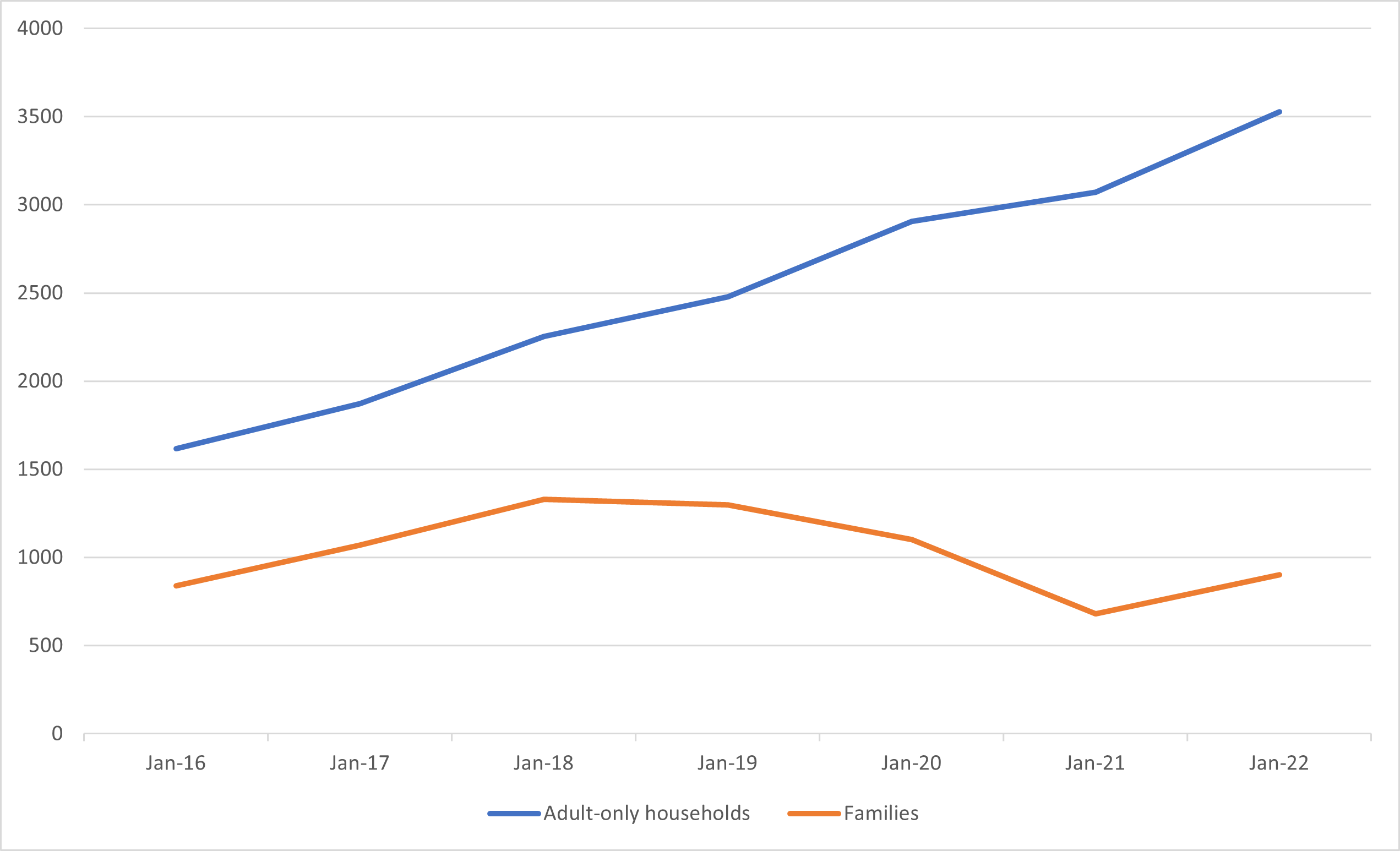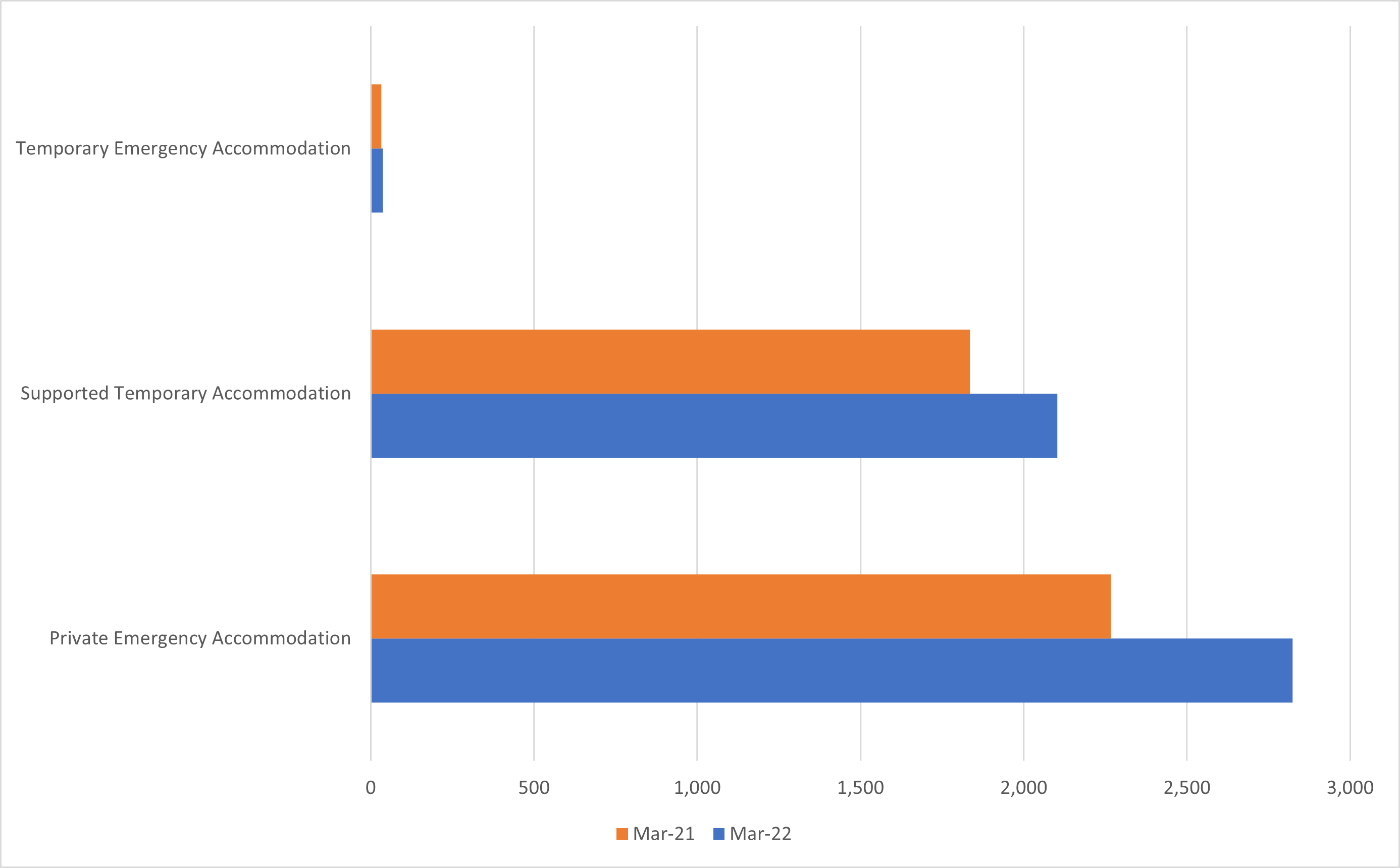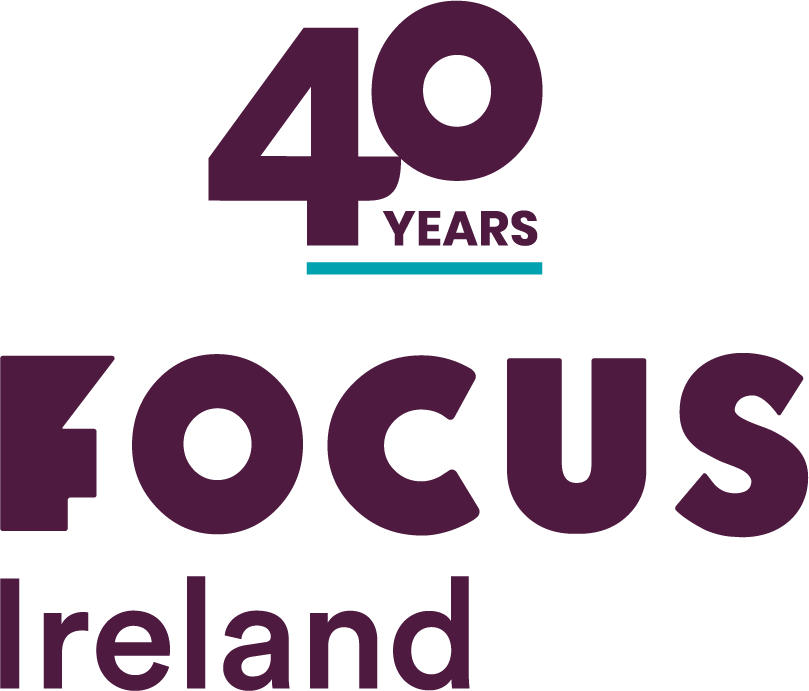Welcome decrease in rough sleeping as adult-only homelessness at record level in Dublin
Author: Emma Byrne
There was a welcomed slight decrease in the number of individuals found rough sleeping in Dublin in Spring 2022 according to figures published by the Dublin Region Homeless Executive (DRHE) last week[1]. The Official Spring Count of people sleeping rough in the Dublin Region was carried out over the week March 28th – April 3rd and identified a total of 91 individuals confirmed as rough sleeping during the week. This is a decrease from the 125 individuals confirmed as rough sleeping during the same period the previous year[2], and a slight decrease from 94 individuals in October 2021[3].
Of the 91 identified individuals, 72 people had PASS IDs, meaning that they had previously engaged with homeless services, or had a PASS record created during the week of the count. Summary statistics of the 72 individuals who were registered on the PASS system shows that the majority of individuals found rough sleeping were male (64%), however, there was a 15% increase in the percentage of females found rough sleeping in the Spring 2022 count compared to the October 2021 count. Most individuals found rough sleeping (67%) were aged 26-45, followed by those aged 46-61 (25%) and the vast majority (90%) had Irish citizenship, with the remaining individuals having citizenship from another EU country.
However, while rough sleeping in the capital has decreased by 27% since this time last year, adult-only homelessness has risen by 15% in Dublin in the same period[4]. While the number of families experiencing homelessness in Dublin has fluctuated in the last 6 years, peaking in 2018, falling significantly when rental protections were introduced during the COVID-19 emergency and beginning to rise again from mid-2021 when rental protections ended, adult-only homelessness in Dublin has been rising steadily during the same 6-year period and is now at its highest ever level as demonstrated by Figure 1. To learn more about the drivers of homelessness in adult-only households see this Focus Ireland blog from 2021.
Figure 1: Individuals in Emergency Accommodation in Dublin, 2016-2022
 Source: Department of Housing, Planning, Community & Local Government
Source: Department of Housing, Planning, Community & Local Government
Increase in use of Private Emergency Accommodation (PEA)
It is positive that the increase in adult-only households experiencing homelessness in Dublin has not appeared to increase the number of people rough sleeping in the snapshot provided by the bi-annual counts. Instead, it appears that most people who rough sleep in the Dublin region move back and forth between different forms of homelessness, including rough sleeping, accessing emergency homeless accommodation, and staying in insecure accommodation (such as couch surfing with friends or family) as noted in the DRHE report.
While rough sleeping has decreased in the last year, the use of emergency accommodation, specifically private emergency accommodation (PEA) such as hotels, B&Bs and other residential facilities that are used on an emergency basis is increasing in Dublin[4]. In the last year, there has also been a 25% increase in the number of households, both adult-only households and families, accessing private emergency accommodation (PEA) in Dublin as shown in Figure 2 as adult-only homelessness continues to increase and family homelessness began to increase again following the end of Covid-19 emergency rental protections in April 2021.
Figure 2: Homeless Emergency Accommodation Types in Dublin
 Source: Department of Housing, Planning, Community & Local Government
Source: Department of Housing, Planning, Community & Local Government
Regular movement between different forms of homelessness
The Spring 2022 Count paints a clearer picture of how individuals experiencing the most extreme forms of homelessness move between various forms of homelessness regularly, while also showing that there is not a large static group of people who continuously rough sleep in Dublin. Although, it is important to note that a smaller group of 13 individuals were identified in both the April 2022 and October 2021 Counts. Almost all (94%) of the individuals recorded as rough sleeping in the Spring 2022 Count has accessed emergency accommodation at some point prior to the week of the count, and 9 individuals recorded in the Spring Count 2022 had an active tenancy. A further 11 individuals had a booking for emergency accommodation on the same night of their engagement with those carrying out the count.
This clearly demonstrates that homelessness is not a linear process of moving from rough sleeping to emergency homeless hostels to a long-term home. Rather, it appears from the DRHE report that the reality is much more complex and chaotic, with many fluctuations occurring for adult-only households experiencing homelessness.
Homelessness, particularly the most extreme forms of homelessness like rough sleeping and accessing emergency hostels, is a traumatic and chaotic experience. The reasons that people rough sleep are often complex, and thus the solutions to ending rough sleeping must be equally complex and intense. Housing First, a housing-led approach with intensive wrap-around support, is the primary model used in Ireland to support people with experience of rough sleeping out of homelessness and one of the core principles of Housing First is the long-term continuation of intensive support for people who have experienced long-term homelessness and rough sleeping.
The Spring Count 2022 clearly highlights how necessary the continuation of long-term support is for people who have experienced the chaos and trauma of homelessness, including for those who have an active tenancy. As Housing First continues to expand across Ireland, of course the provision of secure housing is essential, but the Spring 2022 count also demonstrates why trauma-informed and intensive support should always remain at the core of all Housing First projects.
To learn more about Housing First, see here.
[1] Spring 2022 Count of Rough Sleepers in the Dublin Region available here: https://www.homelessdublin.ie/content/files/Final-Spring-2022-Report-on-people-sleeping-rough-in-the-Dublin-Region.pdf
[2] Spring 2021 Count of Rough Sleepers in the Dublin Region available here: https://www.homelessdublin.ie/content/files/Spring-2021-Count-of-people-sleepng-rough-in-the-Dublin-Region.pdf
[3] Winter 2021 Count of Rough Sleepers in the Dublin Region available here: https://www.dublincity.ie/news/winter-2021-count-rough-sleepers-dublin-region
[4] Department of Housing, Local Government and Heritage. Homeless data available here: https://www.gov.ie/en/collection/80ea8-homelessness-data/#homelessness-data
Focus Blog
16 Days of Activism: Interactions Between Homelessness and Domestic Violence
As part of the 2025 16 Days of Activism Against Gender Based Violence, this blog examines how homelessness and domestic violence intersect along a continuum of harm. The continuum begins with abuse itself, but for many women in Ireland, leaving an abusive relationship does not mark a transition to safety. Instead, harm often changes form. Homelessness and systemic barriers can prolong trauma long after the initial physical violence stops.
Childcare is an essential support for lone parents experiencing homelessness
Childcare is a significant issue for many families in Ireland in 2025. Affordability, capacity, staff shortages and long waiting lists are widely reported and the situation is often described as a childcare crisis.
What does the expenditure on homelessness tell us about the our approach to tackling homelessness?
Despite its technical title, the Focus on Homelessness report “Public Expenditure on Services for Households Experiencing Homelessness” (March 2025), paints a vivid picture of how we have responded to the enduring homelessness crisis over the last decade. The picture it paints is not one driven by vision or ideology, but rather a reactive response which constantly underestimates the scale of the challenge and consumes resources trying to contain, rather than solve, the problem. It also provides hints about what we could do better.
Minister should rethink proposal to remove ‘no fault eviction’ safety net
Minister for Housing, James Browne, has proposed changes to the‘Tenant in situ’ scheme which, while he presents them as ‘refocusing on families’ and ‘new funding’, in reality, will take away the safety net from people facing homelessness due to ‘no-fault evictions. Focus Ireland has written to the Minister, asking him to reconsider the proposal.
What is Youth Homelessness?
Youth homelessness means people aged 13 -26 who are without stable accommodation and staying in hostels, temporary accommodation, couch surfing or rough sleeping. They are facing homelessness at a crucial point in their emotional, cognitive and social development while transitioning from adolescence to adulthood
Where do potential Coalition partners stand on homelessness?
Housing and homelessness was the most important issue for most people in last Friday’s general election, according to Irish Times/RTÉ/TG4/TCD exit poll, with 29% of voters saying that it was their top issue when voting. With all seats now filled, and several potential coalition outcomes now possible, negotiations around housing will likely be one of the deciding factors on whether parties choose to form a coalition government together over the next few weeks.
Non stop increase in adult-only homelessness over last decade shows we need a serious rethink
Our new report shows that adult-only homelessness has been allowed to steadily increase, year on year since 2014, we now have triple the number of homeless adult-only households than we did just a decade ago.
Youth Homelessness: An Obvious Opportunity for Homelessness Prevention
To mark UN International Youth Day, this blog post takes a look at this youth homelessness from the perspective of homelessness prevention. If we wish to truly end homelessness, as we have committed to working towards by 2030, then we must prevent youth homelessness.
Shining a spotlight on women’s homelessness this #IWD2023
On International Women’s Day 2023, Focus Ireland reflects on the current state of women’s homelessness in Ireland and highlights the importance of developing services and policy responses that respond better to the unique needs and experiences of women. This is even more urgent than ever as figures show a 49% rise in the number of women homeless in the last two years.
The winter eviction ban and homelessness: early evidence
The Government’s hasty introduction of a Winter Eviction Ban has failed to halt the rise in the total number of individuals in homelessness so far. The November 2022 homeless figures are the first to reflect the impact of the ban, which came into force at the start of the month but, rather than the decrease that some had predicted, they showed a further increase of 145 to yet another new record level.
An international perspective on Irish homelessness policy
‘From Rebuilding Ireland to Housing for All: international and Irish lessons for tackling homelessness’ was launched in September this year, receiving widespread positive coverage. Here we asked the lead researcher, Professor Nicholas Pleace of York University, to write a guest blog, setting out the main conclusions from the project.
Causes of Family Homelessness in the Dublin Region during the Covid-19 Pandemic
While Covid-19 supended life as know it in 2020, this global disaster has been slowly but surely subsiding. With the roll-out of new vaccines, economies, and societies, have reopened. However, one of the more problematic issues pre-Covid, the use of emergency accommodation to house people experiencing homelessness, is again being used at a much higher rate in the last year.
Why are the numbers of people homeless at record level and what can be done to stop further increases?
With homelessness reaching a new record level in July, this blog looks at why homelessness has risen by 30% in the last year and what immediate and long-term actions must be taken now if we are to stop homeless from rising further.
Solidarity with Young People, Challenging Youth Homelessness: Focus Ireland Youth Services and Advocacy
In recognition of UN International Youth Day, this blog will highlight the risks faced by certain young people in terms of homelessness and housing insecurity, and the supports and services Focus Ireland is providing to address them.
Understanding housing inequalities: The disproportionate risk of homelessness facing migrants living in Ireland
March 2022 saw a sharp rise in the proportion of people with European Union or European Economic Area (EU/EEA) citizenship newly presenting to homeless services, according to figures reported by the Dublin Regional Homeless Executive (DRHE). The increase sparked media speculation concerning the causes of this, the role played by migration, and the implications of this apparent trend for homeless services and the housing sector in general. However, the most recent DRHE Monthly Report to Dublin City Councillors on Homelessness shows that the proportion of new presentations from persons with EU/EEA citizenship markedly fell to a more typical level in April.
Welcome decrease in rough sleeping as adult-only homelessness at record level in Dublin
There was a welcomed slight decrease in the number of individuals found rough sleeping in Dublin in Spring 2022 according to figures published by the Dublin Region Homeless Executive (DRHE) last week . The Official Spring Count of people sleeping rough in the Dublin Region was carried out over the week March 28th – April 3rd and identified a total of 91 individuals confirmed as rough sleeping during the week.
Review of 7 years of spending on homelessness shows it’s time to change
In the first Special Edition of our Focus on Homelessness series, we are looking at Expenditure on Services for Households Experiencing Homelessness. In this blog post, Director of Advocacy Mike Allen outlines why we need a deeper understanding of this, and how this Edition does this.
Why we need an inclusive High Road Covid-Era Back to Work Strategy
In the space of just a few weeks, Covid-19 has fundamentally reconfigured the relationship between welfare and work in Ireland. In this blog post, Dr Mary Murphy, Senior Lecturer at Maynooth University, examines why we need an inclusive high road back to work strategy as we transition out of the Covid-19 pandemic.
Covid-19 and building a society where we can all have a home to stay put in
The Covid-19 pandemic puts people who are homeless at risk disproportionate risk – not only are they more likely to have underlying health issues, they are unable to follow the key recommendations –wash your hands regularly, stay at home and keep a ‘social distance’ from other people.
Understanding the December 2019 homeless figures – Part 1
Having access to accurate numbers is key to informing policy and services responses designed to tackle homelessness. It is equally vital to have the information behind the numbers to be able to clearly understand trends as they develop.


